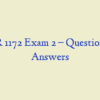Description
CHEM 103 Exam 1-6
EXAM 1
- Convert 1005.3 to exponential form and explain your answer. 2. Convert 4.87 x 10-6 to ordinary form and explain your answer.
- Using the following information, do the conversions shown below, showing all work:
- Do the conversions shown below, showing all work:
- Be sure to show the correct number of significant figures in each calculation.
- 1. 1.35601 contains ? significant figures. 2. 0.151 contains ? significant figures. 3. 1.35601 + 0.151 = ? (give answer to correct number of significant figures)
- Classify each of the following as an element, compound, solution or heterogeneous mixture and explain your answer.
- Classify each of the following as a chemical change or a physical change
- Show the full Nuclear symbol including any + or – charge (n), the atomic number (y), the mass number (x) and the correct element symbol (Z) for each element for which the protons, neutrons and electrons are shown – symbol should appear as follows: xZy+/- n
- Name each of the following chemical compounds. Be sure to name all acids as acids (NOT for instance as binary compounds)
- Write the formula for each of the following chemical compounds explaining the answer with appropriate charges and/or prefixes and/or suffixes.
EXAM 2
- Show the calculation of the molecular weight for the following compounds, reporting your answer to 2 places after the decimal.
- Show the calculation of the number of moles in the given amount of the following substances. Report your answerto 3 significant figures.
- Show the calculation of the number of grams in the given amount of the following substances. Report your answer to 1 place after the decimal.
- Show the calculation of the percent of each element present in the following compounds. Report your answer to 2 places after the decimal.
- Show the calculation of the empirical formula for each compound whose elemental composition is shown below.
- Balance each of the following equations by placing coefficients in front of each substance.
- Classify each of the following reactions as either:
- Show the calculation of the oxidation number (charge) of ONLY the atoms which are changing in the following redox equations.
- Show the balancing of the following redox equation, including the determination of the oxidation number (charge) of ONLY the atoms which are changing.
- Show the balanced equation and the calculation of the number of moles and grams of CO2 formed from 25.4 grams of C8H18. Show your answers to 3 significant figures.
EXAM 3
- A reaction between HCl and NaOH is being studied in a styrofoam coffee cup with NO lid and the heat given off is measured by means of a thermometer immersed in the reaction mixture. Enter the correct thermochemistry term to describe the item listed.
- Show the calculation of the final temperature for a 27.4 gram piece of aluminum heated to 100oC which has been added to a 32.5 gram sample of water at 25.6oC in a coffee cup calorimeter.
- Show the calculation of the amount of heat involved if 18.3 g of S is reacted with excess O2 to yield sulfur trioxide by the following reaction equation. Report your answer to 4 significant figures.
- Show the calculation of the heat of reaction (?Hrxn) for the reaction:
- Show the calculation of the heat of reaction (?Hrxn) for the reaction:
- Show the calculation of the new pressure of a gas sample which has an original volume of 560 ml when collected at 1.05 atm and 32oC when the volume becomes 1.35 liters at 50oC.
- Show the calculation of the volume occupied by a gas sample containing 0.632 mole collected at 710 mm and 35oC.
- Show the calculation of the volume of H2O gas produced by the combustion of
- Show the calculation of the mole fraction of each gas in a 1.00 liter container holding a mixture of 3.62 g of He and 5.45 g of Ne at 25oC.
- Show the calculation of the molecular weight of an unknown gas if the rate of effusion of Neon gas (Ne) is 1.86 times faster than that of an unknown gas.
EXAM 4
- Write the subshell electron configuration (i.e.1s2 2s2, etc.) for the Ni28 atom.
- Write the subshell electron configuration (i.e.1s2 2s2, etc.) for the K19 atom.
- Write the subshell electron configuration (i.e.1s2 2s2, etc.) for the K19 atom and identify which are valence (outer shell) electrons and determine how many valence electrons there are.
- Using up and down arrows, write the orbital diagram for the Ni28 atom.
- Using up and down arrows, write the orbital diagram for the Ni28 atom and identify which are unpaired electrons and determine how many unpaired electrons there are.ccess the Periodic Table.This may be helpful throughout the exam.
- Write the subshell electron configuration (i.e.1s2 2s2, etc.) for the V23 atom and then identify the last electron to fill and write the 4 quantum numbers (n, l, ml and ms) for this electron.
- 1. Arrange the following elements in a vertical list from largest (top) to smallest (bottom) atomic size: Cl, Br, I
- Arrange the following elements in a vertical list from lowest (top) to highest (bottom) electronegativity: S, P, Cl
- Arrange the following elements in a vertical list from highest (top) to lowest (bottom) ionization energy: S, O, Se
- List and explain which of the following atoms holds its valence electrons less tightly.
- On a piece of scratch paper, draw the orbital configuration of the C6 atom and use it to draw the Lewis structure for the C6 atom. Then choose the correct Lewis structure for C6 from the options listed below.
- On a piece of scratch paper, draw the orbital configuration of the P15 atom and use it to draw the Lewis structure for the P15 atom. Then choose the correct Lewis structure for P15 from the options listed below.
EXAM 5
- Show the determination of the charge on the ion formed by the Ga31 atom.
- Using the electronegativities from the table above, show the determination of the polarity of each different type of bond in the following molecule
- On a piece of scratch paper, draw the Lewis structure for the ClO3-1 ion. Then choose the correct Lewis structure for ClO3-1 from the options listed below.
- On a piece of scratch paper, draw the Lewis structure for HClO3. Then choose the correct Lewis structure for HClO3 from the options listed below.
- Determine the electron geometry and explain your answer for the S atom in H2S.
- Determine the hybridization and explain your answer for the S atom in H2S.
- Determine the shape and explain your answer for HCCH.
- Use the electronegativities above and your knowledge of the shape of PH3 to determine the molecular polarity of PH3 explaining your answer in detail.
- Is O2 Polar, Ionic or Nonpolar and List and Explain whether it is Soluble or Insoluble in Water?
- Arrange the following compounds in a vertical list from highest boiling point (top) to lowest boiling point (bottom) and explain your answer on the basis of whether the substance is Polar, Nonpolar, Ionic, Metallic or Hydrogen bonding: Mg, H2O, Ne, HCl, LiCl
EXAM 6
- Explain the difference between amorphous and crystalline solids and give an example of each.
- Which is the least common state of matter among elements solids, liquids or gases? Explain your answer.
- Rank and explain how the freezing point of 0.100 m solutions of the following ionic electrolytes compare, List from lowest freezing point to highest freezing point.
- Mass % = (gsolute / gsolute + gsolvent) x 100%
- Show the calculation of the molality of a solution made by dissolving 28.5 grams
- Show the calculation of the molarity of a solution made by dissolving 27.3 grams of Ca(NO3)2 to make 450 ml of solution. Report your answer to 3 significant figures.
- Show the calculation of the mass of Ba(MnO4)2 needed to make 250 ml of a 0.200 M solution. Report your answer to 3 significant figures.
- Show the calculation of the volume of 0.667 M solution which can be prepared using 37.5 grams of Ba(NO3)2.
- Show the calculation of the boiling point of a solution made by dissolving 20.9 grams of the nonelectrolyte C4H8O4 in 250 grams of water. Kb for water is 0.51, BP of pure water is 100oC. Calculate your answer to 0.01oC.
- Show the calculation of the molar mass (molecular weight) of a solute if a solution of 13.5 grams of the solute in 200 grams of water has a freezing point of -1.20oC. Kf for water is 1.86 and the freezing point of pure water is 0oC. Calculate your answer to 0.1 g/mole.
Final Exam
- 1. Convert 0.0000726 to exponential form and explain your answer. 2. Convert 5.82 x 103 to ordinary form and explain your answer.
- Do the conversions shown below, showing all work:
- Show the calculation of the number of moles in the given amount of the following substances. Report your answerto 3 significant figures.
- Click this link to access the Periodic Table. Show the calculation of the percent of each element present in the following compounds. Report your answer to 2 places after the decimal.
- Show the calculation of the heat of reaction (?Hrxn) for the reaction:
- Show the calculation of the molecular weight of a gas sample with a mass of 0.456 grams which has a volume of 230 ml when collected at 29oC and 740 mm.
- Write the subshell electron configuration (i.e.1s2 2s2, etc.) for the V23 atom and then identify the last electron to fill and write the 4 quantum numbers (n, l, ml and ms) for this electron.
- List and explain which of the following atoms holds its valence electrons less tightly.
- Is KNO3 Polar, Ionic or Nonpolar and List and Explain whether it is Soluble or Insoluble in Water?
- Show the determination of the charge on the ion formed by the Ga31 atom.
- Water (H2O) with a molecular weight of 18 has a boiling point of 100oC and methane (CH4) with a somewhat similar molecular weight of 16 has a boiling point of -161oC. This difference is much higher than can be explained by the polarity of water. Explain what causes this difference.
- Show the calculation of the molar mass (molecular weight) of a solute if a solution of 12.5 grams of the solute in 200 grams of water has a freezing point of -1.30oC. Kf for water is 1.86 and the freezing point of pure water is 0oC. Calculate your answer to 0.1 g/mole.





